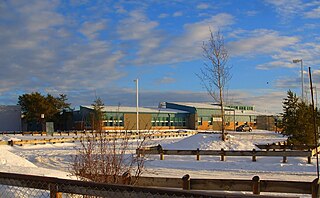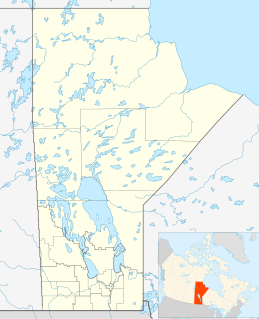
The Chipewyan are an aboriginal Dene ethnolinguistic group of the Athabaskan language family, whose ancestors are identified with the Taltheilei Shale archaeological tradition. They are part of the Northern Athabascan group of peoples, and come from what is now Western Canada.

Cumberland House is a community in Census Division No. 18 in northeast Saskatchewan, Canada on the Saskatchewan River. It is the oldest settler community in Saskatchewan and has a population of about 2,000 people. Cumberland House Provincial Park, which provides tours of an 1890s powder house built by the Hudson's Bay Company, is located nearby.
The Muskoday First Nation is a First Nation band government in Saskatchewan, Canada, composed of Cree and Saulteaux peoples. The First Nation has a registered population of 1,828 people as of September 2014, of which approximately 623 members of the First Nation live on-reserve, and approximately 1204 live off-reserve. Muskoday's territory is located in the aspen parkland biome. It is bordered by the rural municipalities of Birch Hills No. 460 and Prince Albert No. 461.
Wasagamack First Nation is an Oji-Cree First Nation band government in Manitoba, Canada. As of December 2014 the registered population of the Wasagamack First Nation was 2,017, of which 1,823 lived on their own reserve.

Flying Dust First Nation is a Cree First Nation band government located adjacent to the city of Meadow Lake in Saskatchewan, Canada. Highway 55 goes though the band's reserve community.
Wapekeka First Nation is a First Nation band government in the Canadian province of Ontario. An Oji-Cree community in the Kenora District, the community is located approximately 450 kilometres northeast of Sioux Lookout. In January, 2008, the total registered population was 375, of which the on-reserve population was 355.
Waterhen Lake First Nation is a Cree First Nation band government located in northwestern Saskatchewan, Canada. As of October 2018 the total membership of the Waterhen Lake First Nation was 2,053. There were 983 members living on reserve, 2 on Crown Land and 1,068 members living off reserve. The First Nation is a member of the MLTC Program Services, a regional tribal Chiefs' Council. The First Nation is also a signatory to the Adhesion to Treaty 6 in 1921.

Canoe Lake 165 is an Indian reserve of the Canoe Lake Cree First Nation in the boreal forest of northern Saskatchewan, Canada. Its location is on Canoe Lake approximately thirty miles west of Beauval, within ancient hunting grounds of the Woodland Cree. The reserve includes the settlement of Canoe Narrows.

Weenusk First Nation is a Cree First Nation band government in the Canadian province of Ontario. In September, 2007, its total registered population was 516. Weenusk First Nation was an independent member of the Nishnawbe Aski Nation (NAN) but now have joined the Mushkegowuk Council, a regional tribal council, who is also a member of NAN.
Skownan First Nation is a Saulteaux (Ojibwa) First Nations band government whose reserve community, Waterhen Indian Reserve No. 45, a.k.a. "Waterhen", is located 288 km north of Winnipeg, Manitoba, Canada, on the south shore of Waterhen Lake, between Lake Winnipeg and Lake Winnipegosis. As of May, 2015, the First Nation had 1,464 registered members, of which 750 lived on-reserve.

Onion Lake Cree Nation, comprising the adjacent Makaoo 120 and Seekaskootch 119 Indian reserves, is a Cree First Nation band government in Canada that straddles the Alberta/Saskatchewan provincial border approximately 50 km (31 mi) north of the City of Lloydminster.

Cree Lake is a lake in Saskatchewan, Canada. The lake is the fourth largest in the province and is located west of Reindeer Lake and south of Lake Athabasca. There is no highway access, but the lake is reachable by float plane.

Hatchet Lake Dene Nation is a Dene First Nation in northern Saskatchewan. The main settlement, Wollaston Lake, is an unincorporated community on Wollaston Lake in the boreal forest of northeastern Saskatchewan, Canada.

Marcel Colomb First Nation - (MCFN) Band #328 is a First Nations tribe aka Band, of approximately 417 Registered Rocky Cree people located in the area of Lynn Lake, Manitoba. Located within the reserve is a Water Treatment plant, 14 houses, Band Office and other infrastructure projects under development. The Black Sturgeon Falls Reserve locally referred to as Mile 21 or "the Promised Land", is located within the area of Hughes Lake - approximately 30 kilometres southeast of Lynn Lake.
The Sapotaweyak Cree Nation is a First Nations band government whose reserves are located in Central Manitoba north-east of Swan River. The community is mainly Cree, but has a mixture of Plains Cree, Swampy Cree and Saulteaux languages, a unique dialect shared with Wuskwi Sipihk First Nation to the southwest. They have a number of dispersed reserves, most of which are along the shores of Lake Winnipegosis. The main centre of the community is Shoal River Indian Reserve 65A, located adjacent to Pelican Rapids. About half the community's population resides on the reserve while the other half live off reserve.
The English River Dene Nation is a Dene First Nation band government in Patuanak, Saskatchewan, Canada. Their reserve is in the northern section of this Canadian province. Its territories are in the boreal forest of the Canadian Shield. This First Nation is a member of the Meadow Lake Tribal Council (MLTC).
The Prince Albert Grand Council (PAGC) is a tribal council representing twelve First Nation band governments in the province of Saskatchewan. Its head offices are located in the city of Prince Albert. The tribal council was created in 1977 and is one of the largest in Canada.
Birch Narrows Dene Nation is a Dene First Nation band government in the boreal forest region of northern Saskatchewan, Canada.
Red Earth First Nation is a Cree First Nation band government in Saskatchewan, Canada. It is located 225 kilometres (140 mi) northeast of Prince Albert. The main settlement of Red Earth is located on the Carrot River and accessed by Highway 55. Nearby to the east is the Shoal Lake First Nation.









